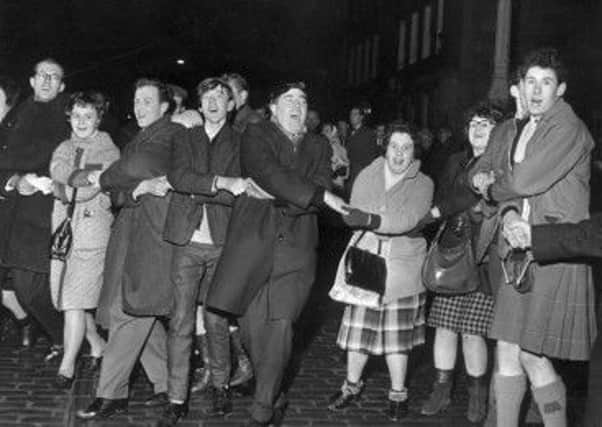Christmas and New Year traditions in Scotland


Take the long-standing custom of fireball swinging in Stonehaven, the transformation of Kirkwall into a football-related battlefield, or the aptly-titled Loony Dook in the Firth of Forth (which, to be fair, isn’t actually that old, having only been set up in 1987): odd rituals such as these reveal an abundance of the sort of festive spirit that can make Hogmanay in Scotland for visitors and locals alike so enjoyable.
Scottish Christmas traditions?
While we’re certainly not the only nation to indulge in strange New Year customs, you might wonder why we’re so well stocked with odd Hogmanay rituals. Part of the answer may lie in a lack of distinctively Scottish Christmas traditions. The reason? Well, Christmas was effectively banned in Scotland for 400 years. Up until the Reformation in 1560, Christmas in Scotland was a religious feasting day celebrated in a way similar to much of Europe. The Kirk did not approve of its celebration because of its perceived association with the Roman Catholic Church, and dismissed it accordingly as a “Popish festival”.


Advertisement
Hide AdA 1640 Act of the Parliament of Scotland made the celebration of “Yule vacations” illegal. England, under Oliver Cromwell, also imposed a ban on Christmas at around the same time. Despite the repealing of the Act in 1686, the suppression of Christmas in Scotland effectively lasted for 400 years, with December 25 only becoming a public holiday in 1958. Boxing Day was not recognised as a festive holiday until 1974. Concrete information on how this state of affairs lasted so long is scant, but it’s clear that the pre-existing emphasis on Hogmanay, coupled with the Presbytarian Church of Scotland’s indifference towards Christmas (even when the Victorians were actively reviving the holiday from its post-Puritan slumber) led most Scots to accept a long-standing status quo.
New Year’s Eve traditions in Scotland
First-footing describes the arrival of your first guest on New Year’s Day. A tall, dark male bearing various gifts is said to bring the most good fortune to a house; fair-haired males and females are traditionally considered unlucky.
The most famous New Year celebrations are held in Edinburgh, where thousands of visitors arrive to soak in (sometimes literally, depending on the weather) the atmosphere at the city’s main thoroughfare, Princes Street. A spectacular fireworks display has been augmented in recent years by multi-stage outdoor concerts and ceilidhs. Street parties of a smaller scale in Scotland’s other major cities are also common. While Hogmanay at the capital is the banner attraction for tourists, street parties are a relatively recent addition to Scotland’s seasonal celebrations. Stonehaven hosts one of Scotland’s most spectacular New Year displays: for nearly a century, residents have been swinging fireballs over their heads, a practice descended from pagan cleansing rituals.
The Kirkwall Ba’ makes for an equally impressive sight; while there are no fireballs in sight, there are plenty of fiery tempers on show. On New Year’s Day (and often on Christmas Day too), Orkney residents turn the entire town into a football pitch, kicking about a cork-stuffed leather ball for an indeterminate period of time.
Redding, where a house is cleaned thoroughly to welcome in the New Year, is another old Hogmanay tradition.
In Burghead, the Burning of the Clavie helps to bring good luck to residents. A flaming barrell filled with tar and staves is carried around town on January 11 (Gaelic New Year’s Day, using the pre-Gregorian calendar, is celebrated on the 12th), then placed in a ruined fort before being allowed to burn out and roll down a hill. January 12, otherwise known as “old new year” in Scotland, also played an important part of Hogmanay celebrations in rural communities: the first Monday after that date was designated Handsel Day, which took place on the first Monday of the new year everywhere else. On Handsel Day, people received small gifts or money; children, servants and other subordinates were often given presents in this way.
Hogmanay poems and songs
Advertisement
Hide AdAuld Lang Syne, partially written by Robert Burns in 1788, is one of the bard’s most well-known and oft-recited verses. It’s a staple of Hogmanay parties across the country, and there’ll be very few who don’t know at least a verse or two (but we’ve republished it below, in case you need a refresher).
Auld Lang Syne
Should auld acquaintance be forgot,
and never brought to mind ?
Should auld acquaintance be forgot,
and auld lang syne* ?
Chorus:
For auld lang syne, my jo,
for auld lang syne,
we’ll tak a cup o’ kindness yet,
for auld lang syne.
And surely ye’ll be your pint-stowp !
and surely I’ll be mine !
And we’ll tak a cup o’ kindness yet,
for auld lang syne.
Chorus
We twa hae run about the braes,
and pu’d the gowans fine ;
But we’ve wander’d mony a weary fit,
sin auld lang syne.
Chorus
We twa hae paidl’d i’ the burn,
frae morning sun till dine ;
But seas between us braid hae roar’d
sin auld lang syne.
Chorus
And there’s a hand, my trusty fiere !
and gie’s a hand o’ thine !
And we’ll tak a right gude-willy waught,
for auld lang syne.
Despite the wealth of literature addressing the festive season, very little besides Auld Lang Syne rings out at Hogmanay parties. Another oft-celebrated Scots writer, Robert Louis Stevenson (1850-1894), published the following passages in Underwoods, a collection of poems released in 1887.
from Ille Terrarum
But noo the auld city, street by street,
An’ winter fu’ o’ snaw an’ sleet,
Awhile shut in my gangrel feet
An’ goavin’ mettle;
Noo is the soopit ingle sweet,
An’ liltin’ kettle.
An’ noo the winter winds complain;
Cauld lies the glaur in ilka lane;
On draigled hizzie, tautit wean
An’ drucken lads,
In the mirk nicht, the winter rain
Dribbles an’ blads.
Whan bugles frae the Castle rock,
An’ beaten drums wi’ dowie shock,
Wauken, at cauld-rife sax o’clock,
My chitterin’ frame,
I mind me on the kintry cock,
The kintry hame.
I mind me on yon bonny bield;
An’ Fancy traivels far afield
To gaither a’ that gairdens yield
O’ sun an’ Simmer:
To hearten up a dowie chield,
Fancy’s the limmer!
Advertisement
Hide AdWilliam Miller (1810-1872), best known for writing Willie Winkie, penned this ode to unforgiving winter weather, John Frost:
You’ve come early to see us this year, John Frost,
Wi’ your crispin’ an’ poutherin’ gear, John Frost,
For hedge, tower, an’ tree,
As far as I see,
Are as white as the bloom o’ the pear, John Frost.
You’re very preceese wi’ your wark, John Frost!
Altho’ ye ha’e wrought in the dark, John Frost,
For ilka fit-stap
Frae the door to the slap,
Is braw as a new linen sark, John Frost.
There are some things about ye I like, John Frost,
And ithers that aft gar me fyke, John Frost;
For the weans, wi’ cauld taes,
Crying “shoon, stockings, claes,”
Keep us busy as bees in the byke, John Frost.
And gae ’wa’ wi’ your lang slides, I beg, John Frost!
Bairn’s banes are as bruckle’s an egg, John Frost;
For a cloit o’ a fa’
Gars them hirple awa’,
Like a hen wi’ a happity leg, John Frost.
Ye ha’e fine goings on in the north, John Frost!
Wi’ your houses o’ ice and so forth, John Frost!
Tho’ their kirn’s on the fire,
They may kirn till they tire,
Yet their butter—pray what is it worth, John Frost?
Now, your breath would be greatly improven, John Frost,
By a scone pipin’-het frae the oven, John Frost;
And your blae frosty nose
Nae beauty wad lose,
Kent ye mair baith o’ boiling and stovin’, John Frost.
William Thom’s (1799-1848) hearty, sing-song meter to the New Year was published sometime in the 19th century. It is less well known, but is great fun to read, and perhaps the most accessible of the selection here.
Come, Scotland’s dearest holiday,
Auld-fashioned, hearty Hogmanay!
How foul or fair the weather be
A kindly welcome waiteth thee;
Whether ye splash through mire and mud
Whaur bickerin’ burnies raise a scud,
Or powdery snaw – nae fricht – nae skaith,
We’ll trachel through a sax-fut wreath,
Rinnin’ full weel – full welcome aye,
Wha come to haud their Hogmanay,
Syne blythelie rings through hut an’ ha’,
‘A health to them that’s far awa’.’
• With thanks to the Scottish Poetry Library